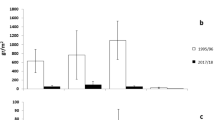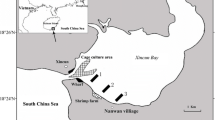Abstract
This study aims to investigate the effects of benthic vegetation colonization on pore water chemistry in river sediments with different organic matter and nutrient loadings. Shoots of Vallisneria spiralis L., surface sediments and water were collected in March 2009 from two fluvial reaches, upstream (U) and downstream (D) an urban wastewater treatment plant. Laboratory microcosms were created with homogenised sediments and macrophytes from each sampling site, half with bare sediments (UB and DB) and half with transplanted shoots of V. spiralis (UV and DV). Microcosms were then incubated over 25 days in two tanks with water from U and D. Approximately every 4 days, three microcosms from each treatment (UB, DB, UV and DV) were terminated, and pore water was analysed for Eh, pH, O2, CO2, CH4, Fe2+, PO4 3−, NH4 +, NO3 − and DRSi. Significant effects of both vegetation and wastewater loadings were found. Vegetated sediments of both sites, especially UV, displayed significantly higher Eh and O2 and significantly lower dissolved CH4, NH4 + and DRSi in pore water compared to bare sediments. At site D, despite an elevated nitrate availability, pore water NH4 + was the preferred N-source for V. spiralis uptake. Unvegetated sediments downstream the sewage plant (DB) exhibited the lowest redox potential and CH4, NH4 +, PO4 3− and Fe2+ accumulation in the pore water. Overall, results from this study suggest that early colonisation by rooted macrophytes affects pore water chemistry towards more oxidized conditions, along with nutrient retention within sediments, which are related to the uptake capacity and oxygen release by roots. They also suggest an elevated physiological plasticity for V. spiralis, as higher organic matter content and lower redox potential in downstream sediments did not affect its functions of ecosystem engineer as benthic metabolism regulator.


Similar content being viewed by others
References
Anderson, L. G., P. O. J. Hall, A. Iverfeldt, M. M. R. van der Loeff, B. Sundby & S. F. G. Westerlund, 1986. Benthic respiration measured by total carbonate production. Limnology and Oceanography 31: 319–329.
Armstrong, W., 1971. Radial oxygen losses from intact rice roots as affected by distance from the apex, respiration and waterlogging. Physiologica Plantarum 25: 192–197.
Armstrong, J. & W. Armstrong, 1988. Phragmites australis: a preliminary study of soil-oxidising sites and internal gas transport pathways. New Phytologist 108: 373–382.
Aspila, K. I., H. Agemian & A. S. Y. Chau, 1976. A semiautomated method for the determination of inorganic, organic and total phosphate in sediments. Analyst 101: 187–197.
Azzoni, R., G. Giordani & P. Viaroli, 2005. Iron-sulphur-phosphorus interactions: implications for sediment buffering capacity in a mediterranean eutrophic lagoon (Sacca di Goro, Italy). Hydrobiologia 550: 131–148.
Barko, J. W., G. Gunnison & S. R. Carpenter, 1991. Sediment interactions with submerged macrophyte growth and community dynamics. Aquatic Botany 41: 41–65.
Boon, P. I. & B. K. Sorrell, 1991. Biogeochemistry of billabong sediments. The effect of macrophytes. Freshwater Biology 26: 209–226.
Bower, C. E. & T. Holm-Hansen, 1980. A salicylate-hypochlorite method for determining ammonia in seawater. Canadian Journal of Fisheries and Aquatic Sciences 37: 794–798.
Carpenter, S. R., J. J. Elser & K. M. Olson, 1983. Effects of roots of Myriophyllum verticilatum L. on sediment redox conditions. Aquatic Botany 17: 243–249.
Carr, G. M. & P. A. Chambers, 1998. Macrophyte growth and sediment phosphorus and nitrogen in a Canadian prairie river. Freshwater Biology 39: 525–536.
Cedergreen, N. & T. V. Madsen, 2003. Nitrate reductase activity in roots and shoots of aquatic macrophytes. Aquatic Botany 76: 203–212.
Dacey, J. W. H., 1980. Internal winds in water lilies: an adaptation for life in anaerobic sediments. Science 210: 1017–1019.
Gerard, G. & J. Chanton, 1993. Quantification of methane oxidation in the rhizosphere of emergent aquatic macrophytes: defining upper limits. Biogeochemistry 23: 79–97.
Golterman, H. L., R. S. Clymo & M. A. M. Ohnstand, 1978. Methods for physical and chemical analysis of fresh waters. I.B.P. Handbook No. 8. Blackwell, Oxford.
Große, W., 1996. The mechanism of thermal transpiration (thermal osmosis). Aquatic Botany 54: 101–110.
Heijs, S. K., R. Azzoni, G. Giordani, H. M. Jonkers, D. Nizzoli, P. Viaroli & H. van Gemerden, 2000. Sulphide-induced release of phosphate from sediments of coastal lagoons and the possible relation to the disappearance of Ruppia sp. Aquatic Microbial Ecology Proceedings of the Conference 23: 85–95.
Heilman, M. & R. G. Carlton, 2001. Methane oxidation associated with submerged vascular macrophytes and its impact on plant diffusive methane flux. Biogeochemistry 52: 207–224.
Hemminga, M. A., 1998. The root/rhizome system of seagrasses: an asset and a burden. Journal of Sea Research 39: 183–196.
Hupfer, M. & A. Dollan, 2003. Immobilisation of phosphorus by iron-coated roots of submerged macrophytes. Hydrobiologia 506: 635–640.
Jaynes, M. L. & S. R. Carpenter, 1986. Effects of vascular and nonvascular macrophytes on sediment redox and solute dynamics. Ecology 67: 875–882.
Jespersen, D. N., B. K. Sorrell & H. Brix, 1998. Growth and root oxygen release by Typha latifolia and its effects on sediment methanogenesis. Aquatic Botany 61: 165–180.
Karjalainen, H., G. Stefansdottir, L. Tuominen & T. Kairesalo, 2001. Do submerged plants enhance microbial activity in sediment? Aquatic Botany 69: 1–13.
Kemp, W. M., M. R. Lewis & T. W. Jones, 1986. Comparison of methods for measuring production by the submerged macrophyte Potamogeton perfoliatus L. Limnology and Oceanography 31: 1322–1334.
Kleeberg, A., J. Köhler, T. Sukhodolova & A. Sukhodolov, 2010. Effects of aquatic macrophytes on organic matter deposition, resuspension and phosphorus entrainment in a lowland river. Freshwater Biology 55: 326–345.
Laskov, C., O. Horn & M. Hupfer, 2006. Environmental factors regulating the radial oxygen loss from roots of Myriophyllum spicatum and Potamogeton crispus. Aquatic Botany 84: 333–340.
Lewis, E. & D. W.R. Wallace, 1998. Program developed for CO2 system calculations. ORNL/CDIAC-105. Carbon Dioxide Information Analysis Center, Oak Ridge National Laboratory, U.S. Department of Energy, Oak Ridge, Tennessee.
Li, F. & Y. Xie, 2009. Spacer elongation and plagiotropic growth are the primary clonal strategies used by Vallisneria spiralis to acclimate to sedimentation. Aquatic Botany 91: 219–223.
Lomstein, B. A., L. Bonne Guldberg, A. T. Amtoft Neubauer, J. Hansen, A. Donnelly, R. A. Herbert, P. Viaroli, G. Giordani, R. Azzoni, R. de Wit & K. Finster, 2006. Benthic decomposition of Ulva lactuca: a controlled laboratory experiment. Aquatic Botany 85: 271–281.
Ma, F. G., S. Goto, K. Tamai & M. Ichii, 2001. Role of root hairs and lateral roots in silicon uptake by rice. Plant Physiology 127: 1773–1780.
Macko, S. A. & N. E. Orstom, 1994. Pollution studies using nitrogen isotopes. In Lajtha, K. & M. M. Michener (eds), Stable isotopes in ecology and environmental science. Blackwell Scientific, Oxford: 45–62.
Michalopoulos, P. & R. C. Aller, 1995. Rapid clay mineral formation in Amazon Delta sediments: reverse weathering and oceanic elemental cycles. Science 270: 614–617.
Neubauer, S. C., K. Givler, S. Valentine & J. P. Megonigal, 2005. Seasonal patterns and plant-mediated controls of subsurface wetland biogeochemistry. Ecology 86: 3334–3344.
Pinardi, M., M. Bartoli, D. Longhi, U. Marzocchi, A. Laini, C. Ribaudo & P. Viaroli, 2009. Benthic metabolism and denitrification in a river reach: a comparison between vegetated and bare sediments. Journal of Limnology 68: 133–145.
R Development Core Team, 2005. R: a language and environment for statistical computing. R Foundation for Statistical Computing, Vienna, Austria. ISBN 3-900051-07-0 [available on internet at http://www.R-project.org].
Risgaard-Petersen, N. & K. Jensen, 1997. Nitrification and denitrification in the rhizosphere of the aquatic macrophyte Lobelia dortmanna L. Limnology and Oceanography 42: 529–537.
Roden, E. E. & R. G. Wetzel, 1996. Organic carbon oxidation and suppression of methane production by microbial Fe(III) oxide reduction in vegetated and unvegetated freshwater wetland sediments. Limnology and Oceanography 41: 1733–1748.
Sand-Jensen, K., 1998. Influence of submerged macrophytes on sediment composition and near-bed flow in lowland streams. Freshwater Biology 39: 663–679.
Sand-Jensen, K. & J. Borum, 1991. Interactions among phytoplankton, periphyton, and macrophytes in temperate freshwater and estuaries. Aquatic Botany 41: 137–175.
Sand-Jensen, K. & C. Prahl, 1982. Oxygen exchange with the lacunae and across leaves and roots of the submerged vascular macrophyte, Lobelia dortmanna L. New Phytologist 91: 103–120.
Sand-Jensen, K., C. Prahl & H. Stockholm, 1982. Oxygen release from roots of submerged aquatic macrophytes. Oikos 38: 349–354.
Sand-Jensen, K. et al., 2008. Outstanding Lobelia dortmana in iron armor. Plant Signaling & Behaviour 3(10): 882–884.
Sigmon, D. E. & L. B. Cahoon, 1997. Comparative effects of benthic microalgae and phytoplankton on dissolved silica fluxes. Aquatic Microbial Ecology Proceedings of the Conference 13: 275–284.
Soda, S., M. Ike, Y. Ogasawara, M. Yoshinaka, D. Mishima & M. Fujita, 2007. Effects of light intensity and water temperature on oxygen release from roots into water lettuce rhizosphere. Water Research 41: 487–491.
Stookey, L. L., 1970. Ferrozine: a new spectrophotometric reagent for iron. Analytical Chemistry 42: 779–781.
Struyf, E. & D. J. Conley, 2009. Silica: an essential nutrient in wetland biogeochemistry. Frontiers in Ecology and the Environment 7: 88–94.
Tallberg, P., 1999. The magnitude of Si dissolution from diatoms at the sediment surface and its potential impact on P mobilization. Archives of Hydrobiology 144(4): 429–438.
Valderrama, J. C., 1977. Methods used by the hydrographica department of the national board of fisheries. Goteborg, Sweden.
van der Nat, F. W. A. & J. J. Middelburg, 1998. Seasonal variation in methane oxidation by the rhizosphere of Phragmites australis and Scirpus lacustris. Aquatic Botany 61: 95–110.
Wang, J. & D. Yu, 2007. Influence of sediment fertility on morphological variability of Vallisneria spiralis L. Aquatic Botany 87: 127–133.
Wigand, C., J. C. Stevenson & J. C. Cornwell, 1997. Effects of different submerged macrophytes on sediment biogeochemistry. Aquatic Botany 56: 233–244.
Wigand, C., J. Wehr, K. Limburg, B. Gorham, S. Longergan & S. Findlay, 2000. Effect of Vallisneria americana (L.) on community structure and ecosystem function in lake mesocosms. Hydrobiologia 418: 137–146.
Xie, Y., S. An & B. Wu, 2005. Resource allocation in the submerged plant Vallisneria natans related to sediment type, rather than water-column nutrients. Freshwater Biology 50: 391–402.
Acknowledgments
E. Racchetti acknowledges the Fondazione Lombardia per l’Ambiente (FLA) for supporting her research activity.
Author information
Authors and Affiliations
Corresponding author
Additional information
Handling editor: S. M. Thomaz
Rights and permissions
About this article
Cite this article
Racchetti, E., Bartoli, M., Ribaudo, C. et al. Short term changes in pore water chemistry in river sediments during the early colonization by Vallisneria spiralis . Hydrobiologia 652, 127–137 (2010). https://doi.org/10.1007/s10750-010-0324-6
Received:
Revised:
Accepted:
Published:
Issue Date:
DOI: https://doi.org/10.1007/s10750-010-0324-6




